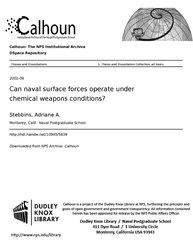File:Can naval surface forces operate under chemical weapons conditions? (IA cnavalsurfacefor109455839).pdf

Original file (1,275 × 1,650 pixels, file size: 655 KB, MIME type: application/pdf, 80 pages)
Captions
Captions
Summary[edit]
| Can naval surface forces operate under chemical weapons conditions?
( |
||
|---|---|---|
| Author |
Stebbins, Adriane A. |
|
| Title |
Can naval surface forces operate under chemical weapons conditions? |
|
| Publisher |
Monterey, Calif. Naval Postgraduate School |
|
| Description |
The acquisition and modernization of chemical warfare (CW) capabilities by state and non-state actors, coupled with the vulnerability of ships restricted in maneuverability to chemical weapons attacks, makes CW defense an increased priority for the U.S. Navy. Adversaries may be deterred from using chemical weapons against naval forces if the U.S. Navy demonstrates that it can continue operations under CW conditions. In order to conduct a psychological operations campaign that will achieve the desired result, naval forces must be prepared to conduct operations in CW environments while simultaneously protecting personnel from the effects of chemical weapons. This thesis applies the principles of chemical defense outlined in Joint Publication 3-11- contamination avoidance, protection, and decontamination-to requirements for naval operations. It then compares the current doctrine, training, organization, and equipment of the U.S. Navy to the requirements generated by the Department of Defense. This thesis argues that the ability of the U.S. Navy to conduct military operations in CW environments could be improved through expanded operational doctrine, a reorganization of shipboard roles for CW defense, integrated and realistic unit training, and additional procurement of collective protection systems. Implementation of these modest recommendations can dramatically increase the CW preparedness of the U.S. Navy. Subjects: Chemical warfare; Chemical weapons |
|
| Language | English | |
| Publication date | June 2002 | |
| Current location |
IA Collections: navalpostgraduateschoollibrary; fedlink |
|
| Accession number |
cnavalsurfacefor109455839 |
|
| Source | ||
| Permission (Reusing this file) |
This publication is a work of the U.S. Government as defined in Title 17, United States Code, Section 101. As such, it is in the public domain, and under the provisions of Title 17, United States Code, Section 105, may not be copyrighted. | |
Licensing[edit]
| Public domainPublic domainfalsefalse |
This work is in the public domain in the United States because it is a work prepared by an officer or employee of the United States Government as part of that person’s official duties under the terms of Title 17, Chapter 1, Section 105 of the US Code.
Note: This only applies to original works of the Federal Government and not to the work of any individual U.S. state, territory, commonwealth, county, municipality, or any other subdivision. This template also does not apply to postage stamp designs published by the United States Postal Service since 1978. (See § 313.6(C)(1) of Compendium of U.S. Copyright Office Practices). It also does not apply to certain US coins; see The US Mint Terms of Use.
|
 | |
| This file has been identified as being free of known restrictions under copyright law, including all related and neighboring rights. | ||
https://creativecommons.org/publicdomain/mark/1.0/PDMCreative Commons Public Domain Mark 1.0falsefalse
File history
Click on a date/time to view the file as it appeared at that time.
| Date/Time | Thumbnail | Dimensions | User | Comment | |
|---|---|---|---|---|---|
| current | 19:17, 15 July 2020 |  | 1,275 × 1,650, 80 pages (655 KB) | Fæ (talk | contribs) | FEDLINK - United States Federal Collection cnavalsurfacefor109455839 (User talk:Fæ/IA books#Fork8) (batch 1993-2020 #11535) |
You cannot overwrite this file.
File usage on Commons
The following page uses this file:
Metadata
This file contains additional information such as Exif metadata which may have been added by the digital camera, scanner, or software program used to create or digitize it. If the file has been modified from its original state, some details such as the timestamp may not fully reflect those of the original file. The timestamp is only as accurate as the clock in the camera, and it may be completely wrong.
| Short title | Can naval surface forces operate under chemical weapons conditions? |
|---|---|
| Author | Stebbins, Adriane A. |
| Software used | Stebbins, Adriane A. |
| Conversion program | Acrobat Distiller 5.0 (Windows) |
| Encrypted | no |
| Page size | 612 x 792 pts (letter) |
| Version of PDF format | 1.4 |

